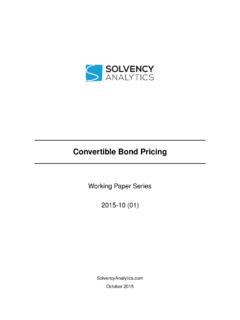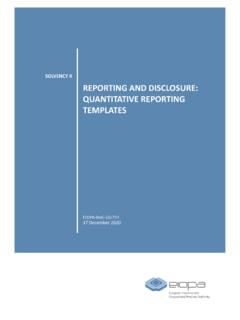Transcription of Standard Formula Solvency Capital Requirement
1 1 October 2019 In October 2019, EIOPA published a consultation paper on its opinion on the Solvency II 2020 review. This briefing note summarises the section of the consultation paper on the Solvency Capital Requirement . EIOPA has requested stakeholders to provide feedback on this consultation paper by 15 January 2020. Overview On 11 February 2019, the European Commission (EC) issued a formal Call for Advice1 to the European Insurance and Occupational Pensions Authority (EIOPA) on the review of the Solvency II Directive. This relates to the full review of the Solvency II rules required by the end of 2020 (2020 Review) as required by the Solvency II Directive.
2 On 25 June 2019 EIOPA published a first wave of consultation papers on its proposals for the 2020 Review regarding supervisory reporting and public disclosure and Insurance Guarantee Schemes. Milliman has written briefing notes on each of these papers (available here). On 15 October 2019 EIOPA issued a second wave of consultation entitled Consultation Paper on the Opinion on the 2020 review of Solvency II (the CP). This was accompanied by an impact assessment document including an assessment of the combined impact of the proposed changes. The CP is 878 pages long and covers a wide range of topics as follows: Long-Term Guarantee (LTG) and equity risk measures Technical Provisions Own funds Solvency Capital Requirement (SCR) Minimum Capital Requirement (MCR) Reporting and disclosure Proportionality Group supervision Freedom to provide Services (FoS) and Freedom of Establishment (FoE) Macroprudential policy Recovery and resolution Fit and proper requirements Milliman has produced a briefing note giving a summary of EIOPA s proposals in the CP (available here)
3 And separate 1 Formal request to EIOPA for technical advice on the review of the Solvency II Directive briefing notes covering each of these topics in more detail. This briefing note covers the Standard Formula SCR, in particular: Interest rate risk Spread risk Property risk Correlation matrices Counterparty default risk Calibration of underwriting risk Non-life catastrophe risk Risk mitigation techniques Reducing the reliance on external credit ratings Transitional on government bonds Interest Rate Risk EIOPA believes that the current shocks for interest rate risk provided in the Delegated Regulation do not meet the Requirement of Article 101(3) of the Solvency II Directive ( that the SCR should correspond to the Value-at-Risk of the basic own funds at a confidence level of over a one-year period).
4 EIOPA therefore strongly advises changing the way the Capital requirements for interest rate risk are calculated in the Delegated Regulation. EIOPA states that the interest rate risk is a material risk and that the current approach for calculating the interest rate risk Capital requirements severely underestimates interest rate risk on the basis that: Actual interest rate movements have been much stronger than those provided by the stresses in the Delegated Regulation; The current approach does not stress negative rates, while reality has shown that rates can continue to decrease; Internal model users measure interest rate risk in a significantly different manner to the current Standard Formula .
5 EIOPA Consultation Paper on the Opinion on the 2020 review of Solvency II Standard Formula Solvency Capital Requirement EIOPA has thus analysed several approaches to improve the interest rate Capital charge calibration. EIOPA recommended a relative shift approach for calibration for the following reasons: the methodology is simple and transparent; the shifted approach is a purely data-driven approach; it is a risk-sensitive approach that remains applicable in any interest rate environment; and it can well cope with low and negative interest rates. EIOPA believes that the relative shift approach is the most appropriate approach to model interest rate risk in the SCR Standard Formula .
6 EIOPA therefore proposes to model interest rate risk in the Standard Formula using a relative shift approach. The parameters of the calculation will vary based on maturity. A comparison of the curves before and after the proposed changes is shown in Appendix A. Spread Risk The Capital Requirement for spread risk is calculated using shocks to credit spreads with a probability of occurrence within one year. The issue identified with the spread risk Capital Requirement is whether the short-term treatment of spread risk overestimates the Capital Requirement in Solvency II. It is often argued that the short-term, 'artificial' changes in credit spreads are not relevant risks for undertakings with long-term and illiquid liabilities.
7 EIOPA has assessed whether the methods, assumptions and Standard parameters underlying the calculation of the market risk module with the Standard Formula appropriately reflect the long-term nature of the insurance business, in particular equity risk and spread risk. During the analysis on spread risk, EIOPA identified the characteristics of insurance business and liabilities that enable insurers to hold their investments for the long term. EIOPA identified four mutually exclusive options for addressing the issue identified: Option 1: No change to the current SCR spread risk sub-module Option 2: Long-term treatment of long-term investments in bonds and loans: avoidance of forced sales and reduced, long-term spread shocks Option 3: Long-term treatment of long-term investments in bonds and loans: hold-to-maturity conditions and spread risk charge based on increase in fundamental spreads Option 4: Reflection of a dynamic VA in the Standard Formula for bonds and loans covering illiquid/predictable liabilities EIOPA's advice is to not modify the current SCR spread risk sub-module (Option 1).
8 EIOPA believes that the introduction of an additional, long-term treatment for investment in fixed income assets (beyond the current long-term calculation of the spread risk charge of assets contained in matching adjustment portfolios) is unnecessary and unwarranted. EIOPA states that it does not believe that investment in fixed income assets is dis-incentivised by the current treatment. It also states that a long term treatment would be inconsistent with the fundamental principle that the SCR should ensure the market value of assets exceeds the market value of liabilities with certainty within one year. Property Risk Currently, the Standard Formula property risk sub-module of the SCR is calculated by considering the impact on the value of assets, liabilities and financial instruments of an instantaneous decrease of value of immovable property of 25%.
9 The stress was calibrated based on historical property prices in the UK property market, as EIOPA view it as the only country where there is suitable source of data to use for the calibration. Some stakeholders have raised concerns that the single shock is not appropriate as it neglects consideration of the different risk profile of property in different geographies and markets: Geographies: Real estate markets, in particular the volatility of property assets, can differ significantly between Member States. In particular, the UK real estate market is deemed to be the most volatile in Europe, so the 25% shock is considered excessively high for non-UK EU property markets.
10 Types of property: commercial property and residential property have very different price volatility. In addition, the single-shock implies that there is no benefit of diversifying property risk by investing in property in different geographies or sectors. AVAILABILITY OF SUITABLE DATA EIOPA requires a historical property price index to calibrate the property risk shock. EIOPA requires such an index to meet the following criteria: Representative: the index should be representative of the market it is aiming to summarise; Frequency of reporting: the index must be based on a sufficiently high number of data points, with EIOPA showing a preference for monthly or quarterly indices; Total returns: the index should be based on total returns, include both Capital growth and income generated by the underlying properties; and Based on local currency: to ignore any distortion from changes in exchange rates.


